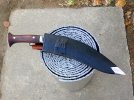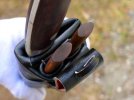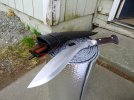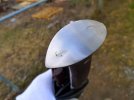The Khukuri world can be confusing to the novice, even at the best of times. So many different models and designs to choose from, each with it's own subtlties. Most designs are geographical, Same knife and made the same way, but with different shapes and weights for different tasks and usually embellished differently. Added to this mix is the fact that these are truly handmade with age old hand tools making no two knives being exactly the same in every way according to length, weight, handle size and balance.
What the novice should first consider is aesthetics. Which model is most pleasing to the individuals eye? Then he must consider what he will likely be using the khukuri for. This is important and will decide whether a dedicated chopper, fighter or something in between will fill ones needs. The next thing to consider is size and weight. Next to deciding what usage is planned this is probably the biggest decision and the hardest one to make, especially without knowledge or guidance from knowledgable people.
To do this one must be a bit introspective. Consider your height, weight and physical ability crucial aspects of the choices you will need to make concerning the proper khukuri. The most important being physical ability. You will need to be able to swing this khukuri multiple times on target to achieve desired results. Bigger is not always better, just harder to repeatedly swing.
What is more important is the mass of the khukuri and its edge. More mass for chopping, less mass for slicing. More obtuse edge beveling for chopping, a less obtuse (finer) edge for slicing. This also holds true for sharpening. You want a "field sharp" (think hatchets/axes) toothy edge for chopping as it will hold up to the infinite stresses of chopping better than a finely beveled scary sharp edge. Fine bevels and scary sharpness are great for weapons and kitchen cutlery, not so much for dedicated chopping.
This is where your height and weight come into play. You want to match size to your stature. A 6' guy with a 12" khukuri not only looks a bit odd for chopping, it is quite impractical. You want a khukuri just long enough to provide a comfortable reach to the target without adding too much weight to pack into the field. Weight is a consideration in that it is what grounds us. Lighter folks will need lighter khukuri and heavier folks will be able to swing a heavier khukuri with no problems.
For most people 6' and under a khukuri from 15" to 18" will be plenty enough. For those people whom are 6' and above 16" to 22" would be appropriate. Anything larger is mostly impractical for carry and usage due to size and weight considerations.
All in all if you sit and ponder these things, it will become clear that it is more or less common sense and simple physics at play here. As you use your khukuri and become familiar with it and it's aesthetics, you will be able to fully realize what all these parameters coming together mean in terms of what you need and what you don't.
The last thing i'd like to discuss is the handmade nature of most real imported Nepalese khukuri.
Because these things are handmade old skool style over a rudimentary coal forge using basic tooling means that not only are no two exactly the same, but that any given piece may have minor imperfections and anomalies associated with such handmade items such as grain marks in horn handles, slight misalignment of keepers, minor warpage and other small issues are not uncommon. We do try to do our best here to keep these things to a bare minimum and sell imperfect items as blemished stock, but due to the nature of the business, they cannot be completely avoided. These are not mass produced, stamped from steel items and some variation in them is to be expected.
Hopefully this simple post has been somewhat educational and understandable.
Auntie Yangdu and I will always gladly try to help guide you in this matter as best we can when time permits, but it is important that you come to understand what I've posted here, so that you can help the next friend that comes to our little forum here in the same situation of not knowing where to begin...
What the novice should first consider is aesthetics. Which model is most pleasing to the individuals eye? Then he must consider what he will likely be using the khukuri for. This is important and will decide whether a dedicated chopper, fighter or something in between will fill ones needs. The next thing to consider is size and weight. Next to deciding what usage is planned this is probably the biggest decision and the hardest one to make, especially without knowledge or guidance from knowledgable people.
To do this one must be a bit introspective. Consider your height, weight and physical ability crucial aspects of the choices you will need to make concerning the proper khukuri. The most important being physical ability. You will need to be able to swing this khukuri multiple times on target to achieve desired results. Bigger is not always better, just harder to repeatedly swing.
What is more important is the mass of the khukuri and its edge. More mass for chopping, less mass for slicing. More obtuse edge beveling for chopping, a less obtuse (finer) edge for slicing. This also holds true for sharpening. You want a "field sharp" (think hatchets/axes) toothy edge for chopping as it will hold up to the infinite stresses of chopping better than a finely beveled scary sharp edge. Fine bevels and scary sharpness are great for weapons and kitchen cutlery, not so much for dedicated chopping.
This is where your height and weight come into play. You want to match size to your stature. A 6' guy with a 12" khukuri not only looks a bit odd for chopping, it is quite impractical. You want a khukuri just long enough to provide a comfortable reach to the target without adding too much weight to pack into the field. Weight is a consideration in that it is what grounds us. Lighter folks will need lighter khukuri and heavier folks will be able to swing a heavier khukuri with no problems.
For most people 6' and under a khukuri from 15" to 18" will be plenty enough. For those people whom are 6' and above 16" to 22" would be appropriate. Anything larger is mostly impractical for carry and usage due to size and weight considerations.
All in all if you sit and ponder these things, it will become clear that it is more or less common sense and simple physics at play here. As you use your khukuri and become familiar with it and it's aesthetics, you will be able to fully realize what all these parameters coming together mean in terms of what you need and what you don't.
The last thing i'd like to discuss is the handmade nature of most real imported Nepalese khukuri.
Because these things are handmade old skool style over a rudimentary coal forge using basic tooling means that not only are no two exactly the same, but that any given piece may have minor imperfections and anomalies associated with such handmade items such as grain marks in horn handles, slight misalignment of keepers, minor warpage and other small issues are not uncommon. We do try to do our best here to keep these things to a bare minimum and sell imperfect items as blemished stock, but due to the nature of the business, they cannot be completely avoided. These are not mass produced, stamped from steel items and some variation in them is to be expected.
Hopefully this simple post has been somewhat educational and understandable.
Auntie Yangdu and I will always gladly try to help guide you in this matter as best we can when time permits, but it is important that you come to understand what I've posted here, so that you can help the next friend that comes to our little forum here in the same situation of not knowing where to begin...





